
If you frequent many of the comics news sites I do, chances are you’ve already seen links to artist
Dennis Culver’s
massive Batman, Inc-inspired image, containing his renderings and redesigns of Batman and his many, many allies—his sidekicks and seconds, The Club of Heroes, The Outsiders, some existing characters Culver decided to Batmanize and even an original character or two.
I know
Chris Sims discussed it at Comics Alliance last week, and
Robot 6 got to it yesterday.
If you haven’t clicked on those first two links, do go do so now. There you’ll also find a similar image featuring 38 Bat-villains (all of whom look fairly awesome, save for a pretty lame Penguin…also, I’ve never heard of this Calendar Girl, but she’s no Calendar Man!), the characters from that
The Wire show everyone seems to like, and a metric ton of great stuff, like
this picture of Red Lantern Dexstarr, the napalm blood-vomiting cat or original characters like
The Turducken (
Culver’s Deviant Art gallery is another good place to spend some time knocking around).
Since character design, superhero costumes and Batman are among my favorite subjects, I thought it would be well worth a blog post to take a closer look at Culver’s work on this piece…particularly since he seems to have solved a lot of what seem like aesthetic problems among the Bat-family of books to me. So maybe you want to open up another window, and point it at
this? (I don’t want to just appropriate Culver’s work here).
The top row features the current core Batman family, which is essentially Batman and his current crop of sidekicks: The retired Batgirl II Cassandra Cain, Red Robin Tim Drake, Batman Bruce Wayne, Batgirl III Stephanie Brown, Robin IV Damian Wayne* and Batman Dick Grayson.
The two Batmen and the littlest Robin seem to be pretty much just straight reproductions of their current costumes. I really hate
the current Batman Prime costume, with the piping and codpiece and
Nintendo Power Gloves, but Culver draws all of these costumes great. I really like the elegant, smooth, only-what’s-necessary linework, and I particularly like the fact that you can tell who is in which Batman costume by their expressions and builds.
Bruce Wayne looks bigger, pissier, scarier and older than Dick Grayson, for example. One neat thing about this huge image is the way Culver seems to be able to communicate a great deal about some of the characters based on simply their posture and expressions (Another good example in this very row is Red Robin vs. Robin).
Three of these, however, are redesigns.
His Cassandra Cain has lost her mask, which I know
some folks don’t care for because it looks fetish-y and bug-like. Personally, I love that Batgirl, even if I think it could stand a bit of tweaking.


I wouldn’t have personally wanted to see so dramatic a change as the one Culver gave her, but I think his image is pretty great. Instead of the full Batman-by-way-of-Black Panther mask, Culver gives her a little movie-Batgirl style domino mask, slims her costume so the boots and gloves are part of the whole and adds a bit of color by making the underside yellow. Looks great.
Culver has a note saying he’d call her Nightwing, a pretty cool name that no one’s using or likely to use for quite a while (Personally, I don’t think
Batman Inc and the two Batmen status quo can last
too long, but I can’t imagine how they’d go back to the old status quo either, which makes it seem like such an exciting story). No one’s doing much of anything with Cassandra Cain, and while I’ve heard she showed up to be written off in the pages of
Red Robin, I haven’t really understood how or why she disappeared from all of the Bat-books. The publisher seems to simply have forgotten about her in 2006, as her book was being canceled, and every appearance since then, mostly ones explaining why she’s not around in some form or another, have made less and less sense.
The other dramatic redesign among this group is that of
Red Robin, former Robin III Tim Drake. As I’ve noted repeatedly, the original Red Robin costume—designed for by Alex Ross for
Kingdom Come, in which a grown-up Robin Dick Grayson became a more Batman-like hero as a grown-up and never took the Nightwing name—was fine for those purposes, but a) Isn’t really all that great a costume and b) doesn’t really fit Tim Drake, as it says “Batman” more than it says “Robin.”
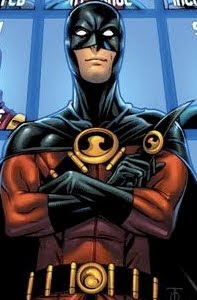

Culver loses the tunic-looking shirt, loses the Batman-style cowl (it’s basically Batman’s cowl with the ears cut off) and gives Tim a more Robin-y domino maks.
I don’t think this goes quite far enough—I’d lose the bandolier too, and maybe the not-red Hawkman-style bird shape, perhaps in favor of a red “R” symbol—but I think this is a thousand times better than his current costume. If the official Red Robin costume is a cross between the original Robin costume as Alex Ross’ Batman costume, then Culver’s design is a cross between the original Red Robin costume and Tim’s last Robin costume, which seems more appropriate.
I don’t like seeing his eyeballs, though!
Finally,
Culver’s Batgirl. I don’t care for Stephanie Brown’s Batgirl costume at all—the ribbing and purple sides with a black front look too
Ultimates, and thus too cutting edge for 2001—but Culver took away its most grotesque element
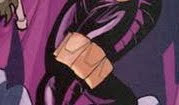
and again improved the costume some one thousand-fold.
The next row down has some of Batman’s closer allies. There’s Jason Bard, an older character that James Robinson seems to have been turning into Batman’s P.I.; Onyx, a character that was seemingly part of Batman’s network of allies for a bit around the time of
War Games; Birds of Prey The Huntress, Oracle and Black Canary and then Flamebird and Batwoman.
Most of these are simply Culver’s versions of the characters in their current designs. He gives
his Onyx a little hair (I liked her
clean-shaven bald, myself), some green highlights to her costume (maybe not the best color, but its not being used all that much among this group, and looks okay here), and a little bat-symbol on her chest. I like it quite a bit, all in all. I don’t think she’s currently appearing in any books, but I could see her wearing this outfit the next time she does. Culver also names her “The Batwoman of Hub City,” which is the original Question’s base of operations. Many of these characters Culver assigns a city, since the conceit of the piece is apparently the recruiting of characters for the
Batman Inc plan of franchised Batmen in major cities all around the world.
I’m not really crazy about his heavily armored version of The Huntress** (her full-body black leotard with purple on top of it and a cross around her neck, the one she started wearing around the “Contagion” storyline in the Bat-books and throughout
JLA,
Nightwing/Huntress and
Cry For Blood remains my favorite), but it looks a hell of a lot better than
a lot the costumes she ends up wearing. His Oracle has her old Batgirl boots on, which look pretty cool, and his Black Canary has lots of yellow highlights over her traditional costume. I don’t really care for that look either, but I do kind of like how different it is.
In the next row, things start to get a bit more...random. There’s Nightrunner, the
“controversial” parkour Batman of Paris introduced in a pair of annuals this year; original Culver creation
Captain Batarang, which takes some design cues from
Captain Boomerang; The Batman of Japan, wearing a version of the
“Science Ninja Hero Batman” costumedesigned by Cliff Chiang
as part of a Justice League/manga amalgam; The Hood, an Alan Grant-created English vigilante
I’ve discussed before, given a more Batman-themed design (I thought that was supposed to be Azrael the first time I saw the image, to be honest) and a redesigned
Acro-Bat, from the pages of the late, great
Chase.
These are all great drawings. I think The Hood looks particularly bad-ass (although I might lose the Bat-symbol over his eyes), and Captain Batarang instantly looks like a character I want to read about. I hope Batman group editor Mike Marts has already seen this image, drooled over it and gave Culver a call to ask him if he’d be interested in developing a Captain Batarang one-shot or story to fill an annual or something (Next year’s
Batman 80-Page Giant, maybe? Ten short stories introducing Batmen of Many Lands tie-ing in to
Batman Inc might be a good theme for it…).
The only one I don’t really like is The Acro-Bat, in part because I think the original character is too cool as is, and this design looks a little too much like Batman Prime (Does anyone actually call Batman Bruce Wayne that? Or am I the only one doing it?)
The next row is the
best row. These are a bunch of pre-existing DC characters who aren’t doing a whole lot at the moment that Culver has given Batman-themed costumes. They’re all from the Morrison/Porter/Dell Justice League, and thus are among some of my favorite under-used characters at the moment: Steel, Aztek, Flash Wally West, Big Barda and Zauriel.
I love each and every one of these costumes. These guys look like an honest-to-God line of action figures.
Here’s Culver’s
Steel, The Batman of Metropolis. Steel previously switched his allegiances from Superman to Batman in the pages of
Kingdom Come. That was one of those many neat little details from the series, a suggested story that we never really got to see play out, one of the stories that was fun to imagine and think about. (
Kingdom Come was full of those, and the story-less characters that populate it’s backgrounds remains my favorite part of the book).
Culver’s Steel is a lot different than Ross’, although I'm having trouble finding an image of Ross' online to cut-and-paste her for comparison's sake. I like Culver’s a lot better, to be honest, but that may have something to do with it being newer.
Steel trading in his Superman S-Shield and red cape for a Bat-symbol and scalloped cape—even if only temporarily—may actually make for a decent DCU story, too. I can’t really imagine what circumstances might lead to it, but I have a feeling Alex Ross and/or Mark Waid probably have at least a few sentences or two worth of story idea already worked out. Why not give Culver those sentences and a couple issues to explore it? Slap some Alex Ross covers on it, and I’m sure it would sell! It certainly wouldn’t sell any worse than, say,
THUNDER Agents or the First Wave books, anyway (Have you heard the simply shocking rumors regarding
First Wave’s possibly imminent demise yet? Who could have predicted launching a whole line of book using obscure characters
before the miniseries introducing them even shipped its second issue would somehow fail? I mean, besides everybody?)
Aztek, “The Ultimate Batman” would be the Batman of Vanity City, the fictional locale of the short-lived, 1996 series
Aztek: The Ultimate Man, which was written by
both Grant Morrison
and Mark Millar, and somehow only lasted 12 issues. Was the market really that different 15 years ago?

I always liked Aztek’s design, particularly his helmet. Culver basically just turns most of the white of his suit black and gives him a Batman cape. It’s been a while since I’ve read
Aztek and the relevant portions of
JLA, but I believe the character was created (in-story) specifically to combat Mageddon, the apocalyptic threat at the climax of Morrison’s
JLA run, and he died doing it. Barring time travel then, I don’t see a reason for an Aztek to exist anymore. Aside from keeping that awesome helmet in the public eye. So I can’t imagine us ever seeing a Bat-Aztek anywhere except right here.
I love
the “Wally West, the Batman of Keystone City” image so much I can barely stand it. It’s a seamless synthesis of the Flash and Batman costumes. This is another character that would probably never in a million years see print (unless in an awesome dream sequence or a
Batman Inc.: Bat-Mite, The Batman of The Fifth Dimension*** miniseries which
oh my God DC you should totally publish a series called that and get Culver to draw it and you could use all of these crazy characters in it…!!!!!!). But it’s pretty cool looking.
I really like the idea of a truly super-powered Batman too, especially one with such a powerful super-power like super-speed (Which I understand may actually be
the best super-power). Also, Wally West isn’t doing a damn thing at the moment, which seems completely crazy. (Do you know what speedster is in the Justice League right now? Jesse Quick. Meanwhile, Justice League founder, Flash Barry Allen, and long-time Justice Leaguer Flash Wally West are…not. I suppose there may be some real-world reason for this, like DC and Geoff Johns not wanting to have anyone write the characters other than Johns until the new take on the franchise gets settled down a bit, but I can’t imagine an in-story rationale for why Jesse Quick is on the JLA and the Flashes aren’t).
Likewise, "Bat Barda" (who “goes wherever she wants) and “Zauriel, The Batman of Los Angeles” probably aren’t going to be appearing in comics much (Heck, Big Barda and Zaruiel probably aren’t going to be appearing in comics much, period). But those are two characters I really love, and two great renditions of them. Culver mainly just tweaked their colors, and added some abstract Bat-shapes into Barda’s practically perfect already costume. (I confess to not having any idea what Barda’s status is, post-
Final Crisis; I’ve never seen any clarification regarding the fate of the New Gods, and it therefore seems a bit unlikely she'll be popping up in, say, a Bat-book any time soon).
The next row includes one more ex-Leaguer with nothing going on, Connor Hawke, followed by Bobo Benetti, Angel and The Ape, Arrowette and Tawky Tawny.
Culver’s Connor Hawke simply changes the green in his costume to black and adds a bat-symbol.
Looks cool to me. Culver also gave him an arrow with a bat-winged tip, but I suppose if Hawke were to become a Batman, he could lose the bow and arrows altogether. It was always stressed that while he was an expert archer, he was a far superior martial artist, and basically just used the bow and arrow to honor his father and one-time namesake.
Alternately, he could lose the bat-symbol and wear this costume and just call himself Black Arrow. I shudder to think of where Connor Hawke really is in the DCU moment; I think last I heard he had renounced Buddhism and superheroing because of the events of
Justice League: Cry For Justice. Did I hear right?
Bobo was one of the many cool characters from James Robinson’s
Starman, and Culver makes him the Batman of Starman’s Opal City, giving him a Bat-symbol shaped tie pin. I can dig that.
Angel and The Ape as the Robin and Batman (respectively) of Gorilla City is pretty goofy, but I could actually see a comic book or short story about that. Putting them in Gorilla City would make it all okay, somehow, I think, especially with the sidekick being a human.
Arrowette looks kind of cool in Bat-garb, I love the Bat-shaped bow, but she’s another character I think we’d be lucky to see appear anywhere at all, let alone as a Bat. I believe she was last seen in the pages of
Young Justice, when she retired from crime-fighting. Since she did so, Judd Winick made
Green Arrow supporting character Mia into Speedy II, so there's already a blond teenage girl archer in the DCU.
As for
Tawky Tawny, “the Batcat of Fawcett City,” he’d probably need Fifth Dimensional Imp help to ever actually appear in a comic. I do dig the idea, but this is maybe my least favorite of Culver’s drawings here. His Tawky looks look a normal man with a tiger’s head, instead of a tiger wearing clothes. Now that I think of it, I’m not entirely sure what the origins of the current, post-
Crisis on Infinite Earths, post-
Infinite Crisis, DCU version of Tawky actually is, but the original was a talking, walking tiger. This depiction does seem somewhat inspired by J.G. Jones’ version from
Final Crisis (
I didn’t much like that one either).
The next row is dedicated to The Club of Heroes, all appearing as we saw them in the Grant Morrison/J.H. Williams III story arc in 2007’s
Batman #667-669. I love all of these characters, I love all of these designs (Dark Ranger’s the only one that doesn’t do all that much for me) and I love these drawings of them. I’m still a little disappointed that Morrison didn’t just give us a straight
Club of Heroes book, but
Batman Inc. seems to be expanding that idea, so I am excited about it. I’m trade-waiting it though, and am pretty bummed out by the delays, which only push eventual trade collection further and further back.
Finally, in the bottom row, we have various Outsiders. It’s been so long since I’ve read an issue of that comic that I’m not sure who’s actually on the team or what their costumes look like, so these could be the current Outsiders or they could just be a bunch of Culver’s favorites. Anyway, they are Metamorpho, Halo, Thunder, Grace, Black Lightning, Geo-Force, Owlman, The Creeper and Katana.
Of these, I just want to note that I like Metamorpho’s pants like that, and I think that may be the coolest I’ve ever seen Halo, Geo-Force and Katana look.



Geo-Force and Katana especially have serious problems wearing costumes that don’t suck, and I think these are among their least sucky costumes of all time.
Geo-Force (stupid, stupid Geo-Force) has changed back and forth between a poor one and a godawful one:
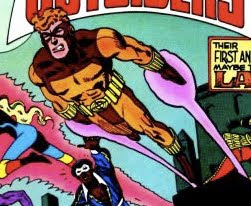

Katana's costumes change more frequently, but I can't tell if they're getting better or worse:

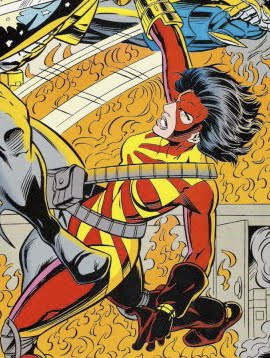
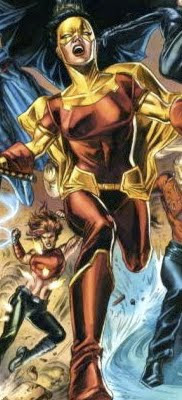

Also, congratulations to Culver for making The Creeper look somehow more insane. Those red, fur or hair-looking tendrils that emanated from his back were among the most striking, off-putting aspects of his original, bizarre design.

I didn’t know exactly what it was, what it was made out of, or what it was doing on The Creeper. As Culver draws it/them though, they seem to be something between a red fur boa and vest and shoulder pads. The fact that The Creeper is wearing it, and seems so confident that it looks good on him makes him one creepy-bordering-on-horrifying character.

Finally, props for giving Black Lightning actual black lightning—
I've been saying for years that he needs to shoot some actual black-colored lightning, in order to make him "work" better in the 21st century.
Wow. That went on much longer than I meant it to. I could really use an editor around here. Anyway, to summarize: Dennis Culver is awesome, his design and art chops are both awesome, you should click all over all his sites and, if you're an editor or publisher (particularly one at DC), you should totally call him up and offer him tons of money to make some of your books more awesome.
*
Or fine, Robin V if you wanna count Stephanie Brown, but I don’t, since she was never intended to be Robin more than a story beat or two**
See the comments for clarification; that Huntress costume is actually Culver's drawing of a Cully Hamner design ***
Actually, Bat-Mite Inc.
sounds better. Make it happen, Mike Marts!
 And, uh, that's all I can tell from looking at this teaser image DC Comics posted last Friday under the title "BEWARE THEIR POWER: WAR OF THE GREEN LANTERNS."
And, uh, that's all I can tell from looking at this teaser image DC Comics posted last Friday under the title "BEWARE THEIR POWER: WAR OF THE GREEN LANTERNS."



















































